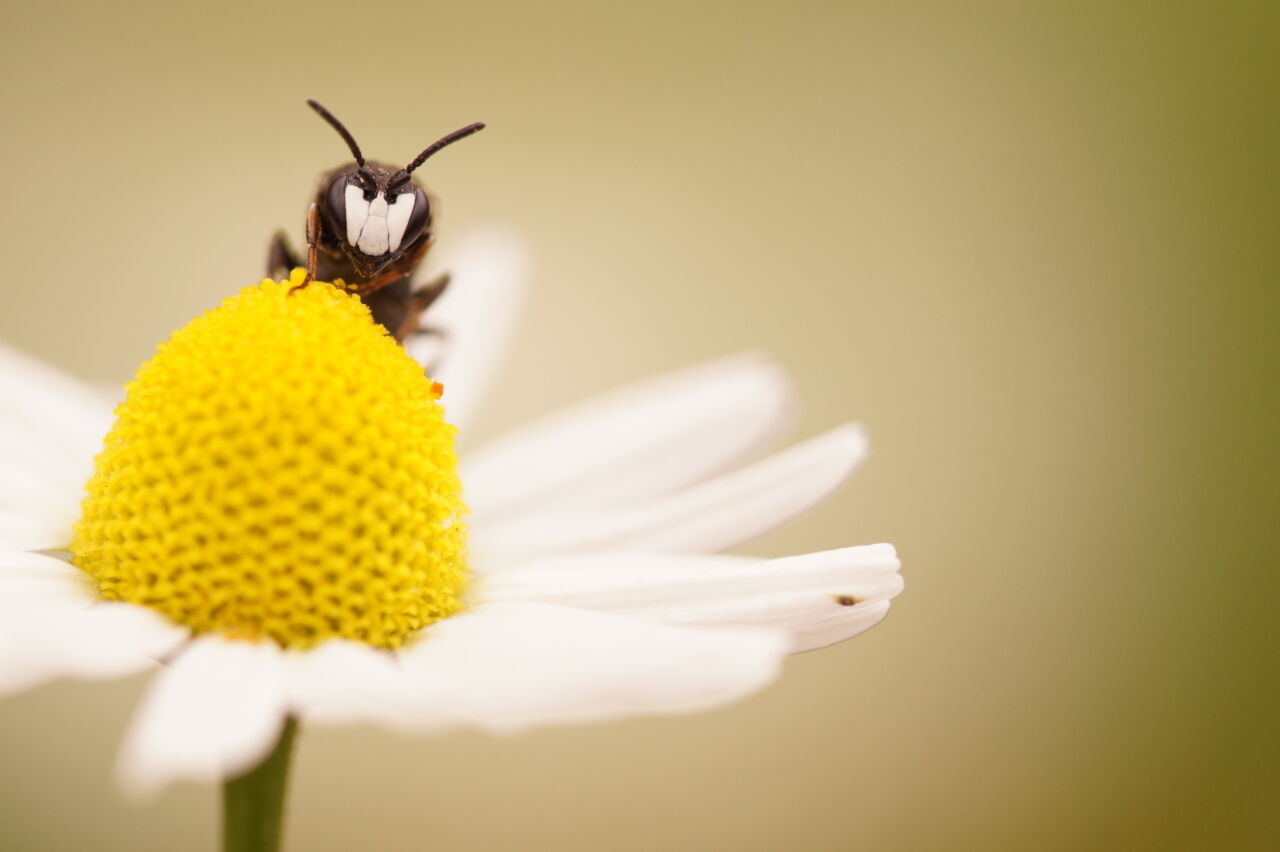No pockets but a mask – The black masked bee
Black masked bees (Hylaeus nigritus) have a distinct way of transporting pollen. Unlike bees that typically use specialized structures like pollen baskets on their hind legs, Hylaeus bees carry pollen internally.

A male black masked bee drinking nectar on a flower. Image: Creative Commons/Sarefo, CC License
Profile
- Hylaeus nigritus (black masked bee) is a solitary bee distributed throughout Europe, the Caucasus and some parts of Russia.
- It belongs to the Hylaeus genus that consists of more than 750 species.
- It is typically 8 to 10 mm long, an average size among Hylaeus species.
- Females build nests consisting of 5–20 brood cells in tiny natural cavities such as rock crevices, cracks in concrete walls or in dry stone walls. The brood cells are lined by the female with a shimmering, transparent secretion.
- The bees live in sand and gravel pits, quarries, in areas with dry stone walls but also in residential areas, gardens and parks.
On desktop: Hold down the Shift key and scroll to zoom in or out of the image. Hold down the left mouse button to rotate.
On mobile: Pinch zoom with two fingers. Use two fingers to pan. Rotate with one finger.
Classification
- Kingdom
- Animalia
- Phylum
- Arthropoda
- Class
- Insecta
- Order
- Hymenoptera
- Family
- Colletidae
- Genus
- Hylaeus
- Species
- Hyaleus nigritus
Mr and Mrs H. nigritus
H. nigritus is sexually dimorphic, which means that females and males do not look alike. Although both are black, females have white triangular marks on their face, while the males' faces are almost completely white giving them the appearance of wearing a mask. Hence the trivial name "black masked bee".

A male Hylaeus nigritus with its characteristic "mask" ingesting pollen from a flower. Image: iNaturalist/Corinna Herr, CC license

A female with white triangle patches on her face. Image: iNaturalist/Felix Riegel, CC license
No, thanks! I don’t need a bag.
Unlike other bees, masked bees do not have a scopa (a brush-like structure to transport pollen) but swallow pollen and nectar and carry it inside their digestive system, specifically in the crop*. Females eject the collected pollen in the brood cells to feed their larvae. Since they carry pollen internally, one needs to dissect the bees to analyze the origin of the pollen grains they collected. This inaccessibility has been limiting our understanding of flower preference of the masked bees and field observations indicated most of the European Hylaeus bees to be generalists. However, a recent study has shown that at least 19 out of 36 Hylaeus species in Central Europe have a strong preference for a single plant family. Hylaeus nigritus appears to be particularly fond of plants in the Asteracea family1.
Another characteristic of black masked bees is their tiny proboscis. It influences the bees' flower preferences directly as they are unable to reach the nectar within flowers that have long nectar tubes. However, their diminutive body size grants them an advantage as they can access the nectar within small flowers by fitting inside them.
What a wasp look!
Unlike most bee species, bees of the Hylaeus genus are less hairy which gives them the appearance of a wasp. An Australian relative of Hylaeus nigritus, Hyleoides concinna, even has orange stripes that make it look like a mud-dauber wasp to its enemies.

Hyleoides concinna is a great imitator of mud-dauber wasps. Image: iNaturalist/Ken Walker, CC license
*Glossary
Crop: The crop is part of an insect's digestive system and is located at the end of the esophagus. Pollen or nectar can be temporarily stored there and later regurgitated (vomited) to feed the larvae.
References
Michener CD. The Bees of the World (2nd ed.). Baltimore: Johns Hopkins University Press. pp. 138,139.
https://www.aussiebee.com.au/hyleoides_concinna.html Accessed 7.5.23
1Müller A. 2023. The hidden diet – examination of crop content reveals distinct patterns of pollen host use by Central European bees of the genus Hylaeus (Hymenoptera, Colletidae). Alpine Entomology 7: 21-35. https://doi.org/10.3897/alpento.7.102639
Westrich P et al. 2000. Rote Liste der Bienen Baden-Württembergs. Naturschutz-Praxis, Artenschutz 4: 56 pp.
